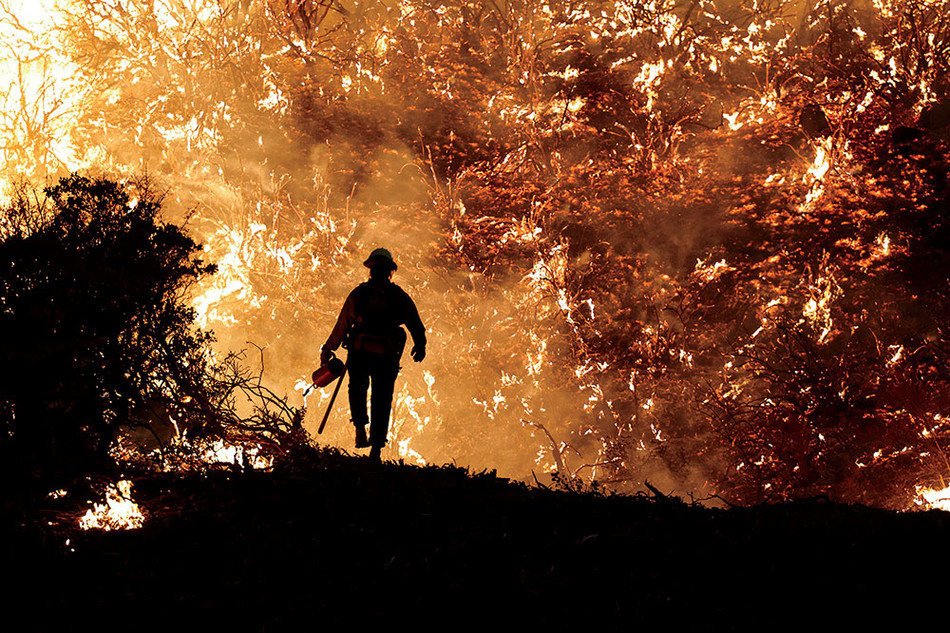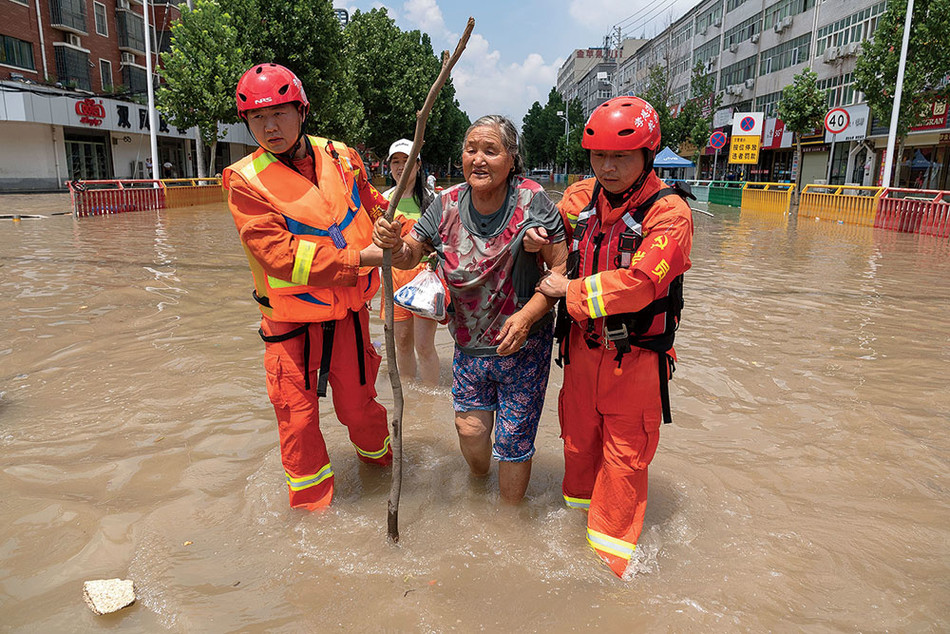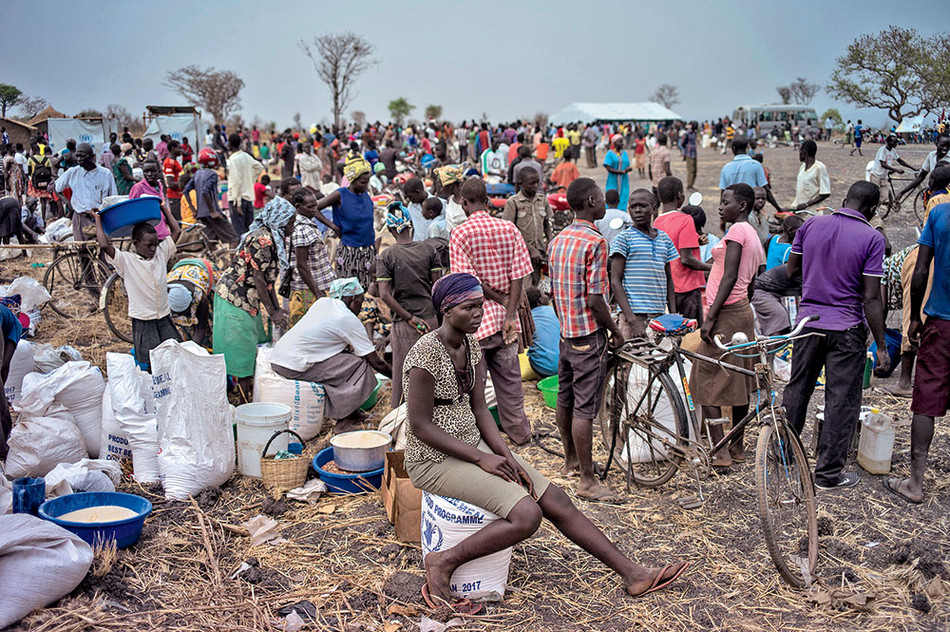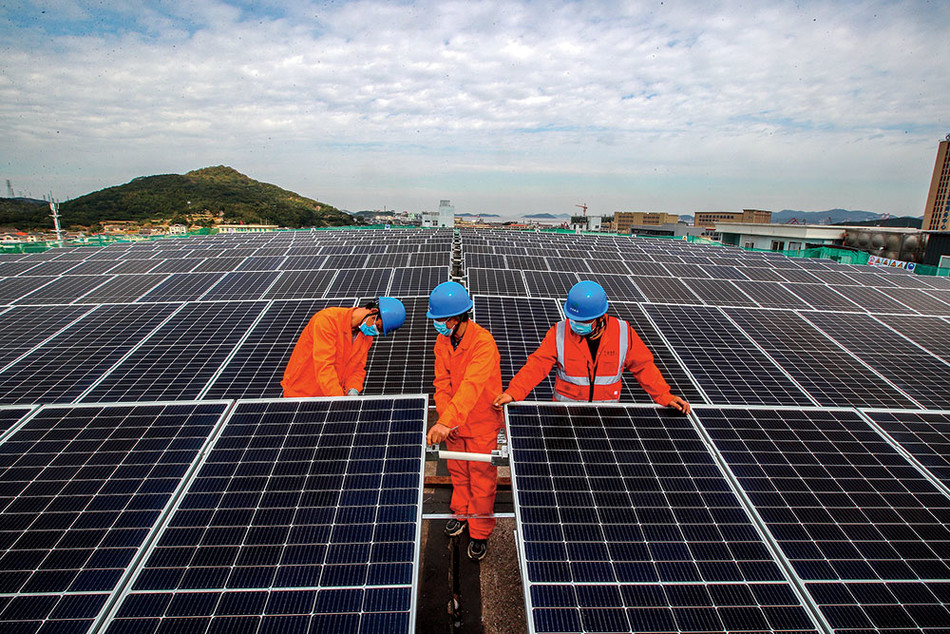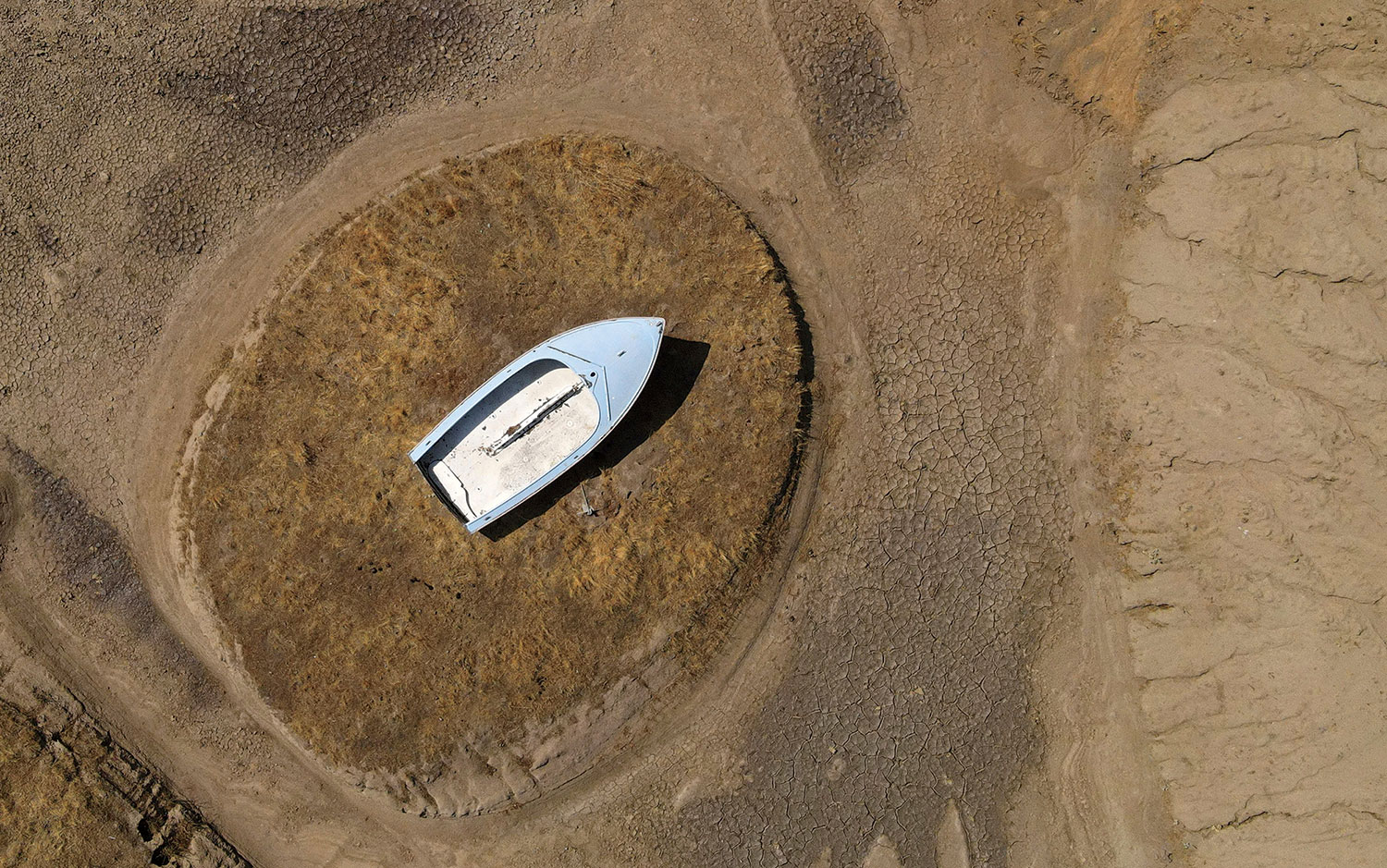
1. More scientists are investigating ways to help people adapt
Over the past half century, thousands of scientists around the world have dedicated their careers to documenting the link between climate change and human activity. A remarkable amount of this work has been done at Columbia’s Lamont-Doherty Earth Observatory, in Palisades, New York. Indeed, one of the founders of modern climate science, the late Columbia geochemist Wally Broecker ’53CC, ’58GSAS, popularized the term “global warming” and first alerted the broader scientific community to the emerging climate crisis in a landmark 1975 paper. He and other Columbia researchers then set about demonstrating that rising global temperatures could not be explained by the earth’s natural long-term climate cycles. For evidence, they relied heavily on Columbia’s world-class collections of tree-ring samples and deep-sea sediment cores, which together provide a unique window into the earth’s climate history.
Today, experts say, the field of climate science is in transition. Having settled the question of whether humans are causing climate change — the evidence is “unequivocal,” according to the UN’s Intergovernmental Panel on Climate Change (IPCC) — many scientists have been branching out into new areas, investigating the myriad ways that global warming is affecting our lives. Columbia scholars from fields as diverse as public health, agriculture, economics, law, political science, urban planning, finance, and engineering are now teaming up with climate scientists to learn how communities can adapt to the immense challenges they are likely to confront.
The University is taking bold steps to support such interdisciplinary thinking. Its new Columbia Climate School, established last year, is designed to serve as a hub for research and education on climate sustainability. Here a new generation of students will be trained to find creative solutions to the climate crisis. Its scholars are asking questions such as: How can communities best protect themselves from rising sea levels and intensifying storm surges, droughts, and heat waves? When extreme weather occurs, what segments of society are most vulnerable? And what types of public policies and ethical principles are needed to ensure fair and equitable adaptation strategies? At the same time, Columbia engineers, physicists, chemists, data scientists, and others are working with entrepreneurs to develop the new technologies that are urgently needed to scale up renewable-energy systems and curb emissions.
“The challenges that we’re facing with climate change are so huge, and so incredibly complex, that we need to bring people together from across the entire University to tackle them,” says Alex Halliday, the founding dean of the Columbia Climate School and the director of the Earth Institute. “Success will mean bringing the resources, knowledge, and capacity of Columbia to the rest of the world and guiding society toward a more sustainable future.”
For climate scientists who have been at the forefront of efforts to document the effects of fossil-fuel emissions on our planet, the shift toward helping people adapt to climate change presents new scientific challenges, as well as the opportunity to translate years of basic research into practical, real-world solutions.
“A lot of climate research has traditionally looked at how the earth’s climate system operates at a global scale and predicted how a given amount of greenhouse-gas emissions will affect global temperatures,” says Adam Sobel, a Columbia applied physicist, mathematician, and climate scientist. “The more urgent questions we face now involve how climate hazards vary across the planet, at local or regional scales, and how those variations translate into specific risks to human society. We also need to learn to communicate climate risks in ways that can facilitate actions to reduce them. This is where climate scientists need to focus more of our energy now, if we’re to maximize the social value of our work.”
2. Big data will enable us to predict extreme weather
Just a few years ago, scientists couldn’t say with any confidence how climate change was affecting storms, floods, droughts, and other extreme weather around the world. But now, armed with unprecedented amounts of real-time and historical weather data, powerful new supercomputers, and a rapidly evolving understanding of how different parts of our climate system interact, researchers are routinely spotting the fingerprints of global warming on our weather.
“Of course, no individual weather event can be attributed solely to climate change, because weather systems are highly dynamic and subject to natural variability,” says Sobel, who studies global warming’s impact on extreme weather. “But data analysis clearly shows that global warming is tilting the scales of nature in a way that is increasing both the frequency and intensity of certain types of events, including heat waves, droughts, and floods.”
According to the World Meteorological Organization, the total number of major weather-related disasters to hit the world annually has increased five-fold since the 1970s. In 2021, the US alone endured eighteen weather-related disasters that caused at least $1 billion in damages. Those included Hurricanes Ida and Nicholas; tropical storms Fred and Elsa; a series of thunderstorms that devastated broad swaths of the Midwest; floods that overwhelmed the coasts of Texas and Louisiana; and a patchwork of wildfires that destroyed parts of California, Oregon, Washington, Idaho, Montana, and Arizona. In 2020, twenty-two $1 billion events struck this country — the most ever.
“The pace and magnitude of the weather disasters we’ve seen over the past couple of years are just bonkers,” says Sobel, who studies the atmospheric dynamics behind hurricanes. (He notes that while hurricanes are growing stronger as a result of climate change, scientists are not yet sure if they are becoming more common.) “Everybody I know who studies this stuff is absolutely stunned by it. When non-scientists ask me what I think about the weather these days, I say, ‘If it makes you worried for the future, it should, because the long-term trend is terrifying.’”
The increasing ferocity of our weather, scientists say, is partly attributable to the fact that warmer air can hold more moisture. This means that more water is evaporating off oceans, lakes, and rivers and accumulating in the sky, resulting in heavier rainstorms. And since hot air also wicks moisture out of soil and vegetation, regions that tend to receive less rainfall, like the American West, North Africa, the Middle East, and Central Asia, are increasingly prone to drought and all its attendant risks. “Climate change is generally making wet areas wetter and dry regions drier,” Sobel says.
But global warming is also altering the earth’s climate system in more profound ways. Columbia glaciologist Marco Tedesco, among others, has found evidence that rising temperatures in the Arctic are weakening the North Atlantic jet stream, a band of westerly winds that influence much of the Northern Hemisphere’s weather. These winds are produced when cold air from the Arctic clashes with warm air coming up from the tropics. But because the Arctic is warming much faster than the rest of the world, the temperature differential between these air flows is diminishing and causing the jet stream to slow down and follow a more wobbly path. As a result, scientists have discovered, storm systems and pockets of hot or cold air that would ordinarily be pushed along quickly by the jet stream are now sometimes hovering over particular locations for days, amplifying their impact. Experts say that the jet stream’s new snail-like pace may explain why a heavy rainstorm parked itself over Zhengzhou, China, for three days last July, dumping an entire year’s worth of precipitation, and why a heat wave that same month brought 120-degree temperatures and killed an estimated 1,400 people in the northwestern US and western Canada.
Many Columbia scientists are pursuing research projects aimed at helping communities prepare for floods, droughts, heat waves, and other threats. Sobel and his colleagues, for example, have been using their knowledge of hurricane dynamics to develop an open-source computer-based risk-assessment model that could help policymakers in coastal cities from New Orleans to Mumbai assess their vulnerability to cyclones as sea levels rise and storms grow stronger. “The goal is to create analytic tools that will reveal how much wind and flood damage would likely occur under different future climate scenarios, as well as the human and economic toll,” says Sobel, whose team has sought input from public-health researchers, urban planners, disaster-management specialists, and civil engineers and is currently collaborating with insurance companies as well as the World Bank, the International Red Cross, and the UN Capital Development Fund. “Few coastal cities have high-quality information of this type, which is necessary for making rational adaptation decisions.”
Radley Horton ’07GSAS, another Columbia climatologist who studies weather extremes; Christian Braneon, a Columbia civil engineer and climate scientist; and Kim Knowlton ’05PH and Thomas Matte, Columbia public-health researchers, are members of the New York City Panel on Climate Change, a scientific advisory body that is helping local officials prepare for increased flooding, temperature spikes, and other climate hazards. New York City has acted decisively to mitigate and adapt to climate change, in part by drawing on the expertise of scientists from Columbia and other local institutions, and its city council recently passed a law requiring municipal agencies to develop a comprehensive long-term plan to protect all neighborhoods against climate threats. The legislation encourages the use of natural measures, like wetland restoration and expansion, to defend against rising sea levels. “There’s a growing emphasis on attending to issues of racial justice as the city develops its adaptation strategies,” says Horton. “In part, that means identifying communities that are most vulnerable to climate impacts because of where they’re located or because they lack resources. We want to make sure that everybody is a part of the resilience conversation and has input about what their neighborhoods need.”
Horton is also conducting basic research that he hopes will inform the development of more geographically targeted climate models. For example, in a series of recent papers on the atmospheric and geographic factors that influence heat waves, he and his team discovered that warm regions located near large bodies of water have become susceptible to heat waves of surprising intensity, accompanied by dangerous humidity. His team has previously shown that in some notoriously hot parts of the world — like northern India, Bangladesh, and the Persian Gulf — the cumulative physiological impact of heat and humidity can approach the upper limits of human tolerance. “We’re talking about conditions in which a perfectly healthy person could actually die of the heat, simply by being outside for several hours, even if they’re resting and drinking plenty of water,” says Horton, explaining that when it is extremely humid, the body loses its ability to sufficiently perspire, which is how it cools itself. Now his team suspects that similarly perilous conditions could in the foreseeable future affect people who live near the Mediterranean, the Black Sea, the Caspian Sea, or even the Great Lakes. “Conditions in these places probably won’t be quite as dangerous as what we’re seeing now in South Asia or the Middle East, but people who are old, sick, or working outside will certainly be at far greater risk than they are today,” Horton says. “And communities will be unprepared, which increases the danger.”
How much worse could the weather get? Over the long term, that will depend on us and how decisively we act to reduce our fossil-fuel emissions. But conditions are likely to continue to deteriorate over the next two to three decades no matter what we do, since the greenhouse gases that we have already added to the atmosphere will take years to dissipate. And the latest IPCC report states that every additional increment of warming will have a larger, more destabilizing impact. Of particular concern, the report cautions, is that in the coming years we are bound to experience many more “compound events,” such as when heat waves and droughts combine to fuel forest fires, or when coastal communities get hit by tropical storms and flooding rivers simultaneously.
“A lot of the extreme weather events that we’ve been experiencing lately are so different from anything we’ve seen that nobody saw them coming,” says Horton, who points out that climate models, which remain our best tool for projecting future climate risks, must constantly be updated with new data as real-world conditions change. “What’s happening now is that the conditions are evolving so rapidly that we’re having to work faster, with larger and more detailed data sets, to keep pace.”
3. The world’s food supply is under threat
“A warmer world could also be a hungry one, even in the rich countries,” writes the Columbia environmental economist Geoffrey Heal in his latest book, Endangered Economies: How the Neglect of Nature Threatens Our Prosperity. “A small temperature rise and a small increase in CO2 concentrations may be good for crops, but beyond a point that we will reach quickly, the productivity of our present crops will drop, possibly sharply.”
Indeed, a number of studies, including several by Columbia scientists, have found that staple crops like corn, rice, wheat, and soybeans are becoming more difficult to cultivate as the planet warms. Wolfram Schlenker, a Columbia economist who studies the impact of climate change on agriculture, has found that corn and soybean plants exposed to temperatures of 90°F or higher for just a few consecutive days will generate much less yield. Consequently, he has estimated that US output of corn and soybeans could decline by 30 to 80 percent this century, depending on how high average temperatures climb.
“This will reduce food availability and push up prices worldwide, since the US is the largest producer and exporter of these commodities,” Schlenker says.
There is also evidence that climate change is reducing the nutritional value of our food. Lewis Ziska, a Columbia professor of environmental health sciences and an expert on plant physiology, has found that as CO2 levels rise, rice plants are producing grains that contain less protein and fewer vitamins and minerals. “Plant biology is all about balance, and when crops suddenly have access to more CO2 but the same amount of soil nutrients, their chemical composition changes,” he says. “The plants look the same, and they may even grow a little bit faster, but they’re not as good for you. They’re carbon-rich and nutrient-poor.” Ziska says that the molecular changes in rice that he has observed are fairly subtle, but he expects that as CO2 levels continue to rise over the next two to three decades, the changes will become more pronounced and have a significant impact on human health. “Wheat, barley, potatoes, and carrots are also losing some of their nutritional value,” he says. “This is going to affect everybody — but especially people in developing countries who depend on grains like wheat and rice for most of their calories.”
Experts also worry that droughts, heat waves, and floods driven by climate change could destroy harvests across entire regions, causing widespread food shortages. A major UN report coauthored by Columbia climate scientist Cynthia Rosenzweig in 2019 described the growing threat of climate-induced hunger, identifying Africa, South America, and Asia as the areas of greatest susceptibility, in part because global warming is accelerating desertification there. Already, some eight hundred million people around the world are chronically undernourished, and that number could grow by 20 percent as a result of climate change in the coming decades, the report found.
In hopes of reversing this trend, Columbia scientists are now spearheading ambitious efforts to improve the food security of some of the world’s most vulnerable populations. For example, at the International Research Institute for Climate and Society (IRI), which is part of the Earth Institute, multidisciplinary teams of climatologists and social scientists are working in Ethiopia, Senegal, Colombia, Guatemala, Bangladesh, and Vietnam to minimize the types of crop losses that often occur when climate change brings more sporadic rainfall. The IRI experts, whose work is supported by Columbia World Projects, are training local meteorologists, agricultural officials, and farmers to use short-term climate-prediction systems to anticipate when an upcoming season’s growing conditions necessitate using drought-resistant or flood-resistant seeds. They can also suggest more favorable planting schedules. To date, they have helped boost crop yields in dozens of small agricultural communities.
“This is a versatile approach that we’re modeling in six nations, with the hope of rolling it out to many others,” says IRI director John Furlow. “Agriculture still dominates the economies of most developing countries, and in order to succeed despite increasingly erratic weather, farmers need to be able to integrate science into their decision-making.”
4. We need to prepare for massive waves of human migration
For thousands of years, the vast majority of the human population has lived in a surprisingly narrow environmental niche, on lands that are fairly close to the equator and offer warm temperatures, ample fresh water, and fertile soils.
But now, suddenly, the environment is changing. The sun’s rays burn hotter, and rainfall is erratic. Some areas are threatened by rising sea levels, and in others the land is turning to dust, forests to kindling. What will people do in the coming years? Will they tough it out and try to adapt, or will they migrate in search of more hospitable territory?
Alex de Sherbinin, a Columbia geographer, is among the first scientists attempting to answer this question empirically. In a series of groundbreaking studies conducted with colleagues at the World Bank, the Potsdam Institute for Climate Impact Research, New York University, Baruch College, and other institutions, he has concluded that enormous waves of human migration will likely occur this century unless governments act quickly to shift their economies away from fossil fuels and thereby slow the pace of global warming. His team’s latest report, published this fall and based on a comprehensive analysis of climatic, demographic, agricultural, and water-use data, predicts that up to 215 million people from Asia, Eastern Europe, Africa, and Latin America — mostly members of agricultural communities, but also some city dwellers on shorelines — will permanently abandon their homes as a result of droughts, crop failures, and sea-level rise by 2050.
“And that’s a conservative estimate,” says de Sherbinin, a senior research scientist at Columbia’s Center for International Earth Science Information Network. “We’re only looking at migration that will occur as the result of the gradual environmental changes occurring where people live, not massive one-time relocations that might be prompted by natural disasters like typhoons or wildfires.”
De Sherbinin and his colleagues do not predict how many climate migrants will ultimately cross international borders in search of greener pastures. Their work to date has focused on anticipating population movements within resource-poor countries in order to help governments develop strategies for preventing exoduses of their own citizens, such as by providing struggling farmers with irrigation systems or crop insurance. They also identify cities that are likely to receive large numbers of new residents from the surrounding countryside, so that local governments can prepare to accommodate them. Among the regions that will see large-scale population movements, the researchers predict, is East Africa, where millions of smallholder farmers will abandon drought-stricken lands and flock to cities like Kampala, Nairobi, and Lilongwe. Similarly, agricultural communities across Latin America, devastated by plummeting corn, bean, and coffee yields, will leave their fields and depart for urban centers. And in Southeast Asia, rice farmers and fishing families in increasingly flood-prone coastal zones like Vietnam’s Mekong Delta, home to twenty-one million people, will retreat inland.
But these migrations, if they do occur, do not necessarily need to be tragic or chaotic affairs, according to de Sherbinin. In fact, he says that with proper planning, and with input from those who are considering moving, it is even possible that large-scale relocations could be organized in ways that ultimately benefit everybody involved, offering families of subsistence farmers who would otherwise face climate-induced food shortages a new start in more fertile locations or in municipalities that offer more education, job training, health care, and other public services.
“Of course, wealthy nations should be doing more to stop climate change and to help people in developing countries adapt to environmental changes, so they have a better chance of thriving where they are,” he says. “But the international community also needs to help poorer countries prepare for these migrations. If and when large numbers of people do find that their lands are no longer habitable, there should be systems in place to help them relocate in ways that work for them, so that they’re not spontaneously fleeing droughts or floods as refugees but are choosing to safely move somewhere they want to go, to a place that’s ready to receive them.”
5. Rising temperatures are already making people sick
One of the deadliest results of climate change, and also one of the most insidious and overlooked, experts say, is the public-health threat posed by rising temperatures and extreme heat.
“Hot weather can trigger changes in the body that have both acute and chronic health consequences,” says Cecilia Sorensen, a Columbia emergency-room physician and public-health researcher. “It actually alters your blood chemistry in ways that make it prone to clotting, which can lead to heart attacks or strokes, and it promotes inflammation, which can contribute to a host of other problems.”
Exposure to severe heat, Sorensen says, has been shown to exacerbate cardiovascular disease, asthma, chronic obstructive pulmonary disease, arthritis, migraines, depression, and anxiety, among other conditions. “So if you live in a hot climate and lack access to air conditioning, or work outdoors, you’re more likely to get sick.”
By destabilizing the natural environment and our relationship to it, climate change is endangering human health in numerous ways. Researchers at Columbia’s Mailman School of Public Health, which launched its innovative Climate and Health Program in 2010, have shown that rising temperatures are making air pollution worse, in part because smog forms faster in warmer weather and because wildfires are spewing enormous amounts of particulate matter into the atmosphere. Global warming is also contributing to food and drinking-water shortages, especially in developing countries. And it is expected to fuel transmission of dengue fever, Lyme disease, West Nile virus, and other diseases by expanding the ranges of mosquitoes and ticks. But experts say that exposure to extreme heat is one of the least understood and fastest growing threats.
“Health-care professionals often fail to notice when heat stress is behind a patient’s chief complaint,” says Sorensen, who directs the Mailman School’s Global Consortium on Climate and Health Education, an initiative launched in 2017 to encourage other schools of public health and medicine to train practitioners to recognize when environmental factors are driving patients’ health problems. “If I’m seeing someone in the ER with neurological symptoms in the middle of a heat wave, for example, I need to quickly figure out whether they’re having a cerebral stroke or a heat stroke, which itself can be fatal if you don’t cool the body down quickly. And then I need to check to see if they’re taking any medications that can cause dehydration or interfere with the body’s ability to cool itself. But these steps aren’t always taken.”
Sorensen says there is evidence to suggest that climate change, in addition to aggravating existing medical conditions, is causing new types of heat-related illnesses to emerge. She points out that tens of thousands of agricultural workers in Central America have died of an enigmatic new kidney ailment that has been dubbed Mesoamerican nephropathy or chronic kidney disease of unknown origin (CKDu), which appears to be the result of persistent heat-induced inflammation. Since CKDu was first observed among sugarcane workers in El Salvador in the 1990s, Sorensen says, it has become endemic in those parts of Central America where heat waves have grown the most ferocious.
“It’s also been spotted among rice farmers in Sri Lanka and laborers in India and Egypt,” says Sorensen, who is collaborating with physicians in Guatemala to develop an occupational-health surveillance system to spot workers who are at risk of developing CKDu. “In total, we think that at least fifty thousand people have died of this condition worldwide.”
Heat waves are now also killing hundreds of Americans each year. Particularly at risk, experts say, are people who live in dense urban neighborhoods that lack trees, open space, reflective rooftops, and other infrastructure that can help dissipate the heat absorbed by asphalt, concrete, and brick. Research has shown that temperatures in such areas can get up to 15°F hotter than in surrounding neighborhoods on summer days. The fact that these so-called “urban heat islands” are inhabited largely by Black and Latino people is now seen as a glaring racial inequity that should be redressed by investing in public-infrastructure projects that would make the neighborhoods cooler and safer.
“It isn’t a coincidence that racially segregated neighborhoods in US cities are much hotter, on average, than adjacent neighborhoods,” says Joan Casey, a Columbia epidemiologist who studies how our natural and built environments influence human health. In fact, in one recent study, Casey and several colleagues showed that urban neighborhoods that lack green space are by and large the same as those that in the 1930s and 1940s were subject to the racist practice known as redlining, in which banks and municipalities designated minority neighborhoods as off-limits for private lending and public investment. “There’s a clear link between that history of institutionalized racism and the subpar public infrastructure we see in these neighborhoods today,” she says.
Extreme heat is hardly the only environmental health hazard faced by residents of historically segregated neighborhoods. Research by Columbia scientists and others has shown that people in these areas are often exposed to dirty air, partly as a result of the large numbers of trucks and buses routed through their streets, and to toxins emanating from industrial sites. But skyrocketing temperatures are exacerbating all of these other health risks, according to Sorensen.
“A big push now among climate scientists and public-health researchers is to gather more street-by-street climate data in major cities so that we know exactly where people are at the greatest risk of heat stress and can more effectively advocate for major infrastructure upgrades in those places,” she says. “In the meantime, there are relatively small things that cities can do now to save lives in the summer — like providing people free air conditioners, opening community cooling centers, and installing more water fountains.”
6. We’re curbing emissions but need to act faster
Since the beginning of the industrial revolution, humans have caused the planet to warm 1.1°C (or about 2°F), mainly by burning coal, oil, and gas for energy. Current policies put the world on pace to increase global temperatures by about 2.6°C over pre-industrial levels by the end of the century. But to avoid the most catastrophic consequences of climate change, we must try to limit the warming to 1.5°C, scientists say. This will require that we retool our energy systems, dramatically expanding the use of renewable resources and eliminating nearly all greenhouse-gas emissions by mid-century.
“We’ll have to build the equivalent of the world’s largest solar park every day for the next thirty years to get to net zero by 2050,” says Jason Bordoff, co-dean of the Columbia Climate School. A leading energy-policy expert, Bordoff served on the National Security Council of President Barack Obama ’83CC. “We’ll also have to ramp up global investments in clean energy R&D from about $2 trillion to $5 trillion per year,” he adds, citing research from the International Energy Agency. “The challenge is enormous.”
Over the past few years, momentum for a clean-energy transition has been accelerating. In the early 2000s, global emissions were increasing 3 percent each year. Now they are rising just 1 percent annually, on average, with some projections indicating that they will peak in the mid-2020s and then start to decline. This is the result of a variety of policies that countries have taken to wean themselves off fossil fuels. European nations, for example, have set strict limits on industrial emissions. South Africa, Chile, New Zealand, and Canada have taken significant steps to phase out coal-fired power plants. And the US and China have enacted fuel-efficiency standards and invested in the development of renewable solar, wind, and geothermal energy — which, along with hydropower, account for nearly 30 percent of all electricity production in the world.
“It’s remarkable how efficient renewables have become over the past decade,” says Bordoff, noting that the costs of solar and wind power have dropped by roughly 90 percent and 70 percent, respectively, in that time. “They’re now competing quite favorably against fossil fuels in many places, even without government subsidies.”
But in the race to create a carbon-neutral global economy, Bordoff says, the biggest hurdles are ahead of us. He points out that we currently have no affordable ways to decarbonize industries like shipping, trucking, air travel, and cement and steel production, which require immense amounts of energy that renewables cannot yet provide. “About half of all the emission reductions that we’ll need to achieve between now and 2050 must come from technologies that aren’t yet available at commercial scale,” says Bordoff.
In order to fulfill the potential of solar and wind energy, we must also improve the capacity of electrical grids to store power. “We need new types of batteries capable of storing energy for longer durations, so that it’s available even on days when it isn’t sunny or windy,” he says.
Perhaps the biggest challenge, Bordoff says, will be scaling up renewable technologies quickly enough to meet the growing demand for electricity in developing nations, which may otherwise choose to build more coal- and gas-fueled power plants. “There are large numbers of people around the world today who have almost no access to electricity, and who in the coming years are going to want to enjoy some of the basic conveniences that we often take for granted, like refrigeration, Internet access, and air conditioning,” he says. “Finding sustainable ways to meet their energy needs is a matter of equity and justice.”
Bordoff, who is co-leading the new Climate School alongside geochemist Alex Halliday, environmental geographer Ruth DeFries, and marine geologist Maureen Raymo ’89GSAS, is also the founding director of SIPA’s Center on Global Energy Policy, which supports research aimed at identifying evidence-based, actionable solutions to the world’s energy needs. With more than fifty affiliate scholars, the center has, since its creation in 2013, established itself as an intellectual powerhouse in the field of energy policy, publishing a steady stream of definitive reports on topics such as the future of coal; the potential for newer, safer forms of nuclear energy to help combat climate change; and the geopolitical ramifications of the shift away from fossil fuels. One of the center’s more influential publications, Energizing America, from 2020, provides a detailed roadmap for how the US can assert itself as an international leader in clean-energy systems by injecting more federal money into the development of technologies that could help decarbonize industries like construction, transportation, agriculture, and manufacturing. President Joe Biden’s $1 trillion Infrastructure Investment and Jobs Act, signed into law in November, incorporates many of the report’s recommendations, earmarking tens of billions of dollars for scientific research in these areas.
“When we sat down to work on that project, my colleagues and I asked ourselves: If an incoming administration wanted to go really big on climate, what would it do? How much money would you need, and where exactly would you put it?” Bordoff says. “I think that’s one of our successes.”
Which isn’t to say that Bordoff considers the climate initiatives currently being pursued by the Biden administration to be sufficient to combat global warming. The vast majority of the climate-mitigation measures contained in the administration’s first two major legislative packages — the infrastructure plan and the more ambitious Build Back Better social-spending bill, which was still being debated in Congress when this magazine went to press — are designed to reward businesses and consumers for making more sustainable choices, like switching to renewable energy sources and purchasing electric vehicles. A truly transformative climate initiative, Bordoff says, would also discourage excessive use of fossil fuels. “Ideally, you’d want to put a price on emissions, such as with a carbon tax or a gasoline tax, so that the biggest emitters are forced to internalize the social costs they’re imposing on everyone else,” he says.
Bordoff is a pragmatist, though, and ever mindful of the fact that public policy is only as durable as it is popular. “I think the American people are more divided on this than we sometimes appreciate,” he says. “Support for climate action is growing in the US, but we have to be cognizant of how policy affects everyday people. There would be concern, maybe even outrage, if electric or gas bills suddenly increased. And that would make it much, much harder to gain and keep support during this transition.”
Today, researchers from across the entire University are working together to pursue a multitude of strategies that may help alleviate the climate crisis. Some are developing nanomaterials for use in ultra-efficient solar cells. Others are inventing methods to suck CO2 out of the air and pump it underground, where it will eventually turn into chalk. Bordoff gets particularly excited when describing the work of engineers at the Columbia Electrochemical Energy Center who are designing powerful new batteries to store solar and wind power. “This is a team of more than a dozen people who are the top battery experts in the world,” he says. “Not only are they developing technologies to create long-duration batteries, but they’re looking for ways to produce them without having to rely on critical minerals like cobalt and lithium, which are in short supply.”
In his own work, Bordoff has recently been exploring the geopolitical ramifications of the energy transition, with an eye toward helping policymakers navigate the shifting international power dynamics that are likely to occur as attention tilts away from fossil fuels in favor of other natural resources.
But he believes the best ideas will come from the next generation of young people, who, like the students in the Climate School’s inaugural class this year, are demanding a better future. “When I see the growing sense of urgency around the world, especially among the younger demographics, it gives me hope,” he says. “The pressure for change is building. Our climate policies don’t go far enough yet, so something is eventually going to have to give — and I don’t think it’s going to be the will and determination of the young people. Sooner or later, they’re going to help push through the more stringent policies that we need. The question is whether it will be in time.”
